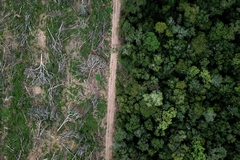Microalgae Hailed for its Striking Potential to Society’s Greatest Challenges
22 Nov 2016 --- A new study predicts big plans for microalgae which it says may soon become a top-tier contender in the fight against global warming, climate change and food insecurity.
In fact, Charles H. Greene, professor of earth and atmospheric sciences at Cornell University, and lead author of the new paper entitled "Marine Microalgae: Climate, Energy and Food Security From the Sea," believes he may have “stumbled onto the next green revolution.”
The study presents an overview of the concept of large-scale industrial cultivation of marine microalgae, or ICMM for short. ICMM could reduce fossil fuel use by supplying liquid hydrocarbon biofuels for the aviation and cargo shipping industries. The biomass of microalgae remaining after the lipids have been removed for biofuels can then be made into nutritious animal feeds or perhaps even consumed by humans.
Scientists harvest freshly grown microalgae, removed most of the water, and then extract the lipids, in order to make biofuel. The remaining defatted biomass is a protein-rich and highly nutritious by product. The idea is that this can be added to feeds for various domesticated farm animals, like chickens and pigs, or aquacultured animals, like salmon and shrimp.

In order to grow enough algae for current global liquid fuel demand, an area three times the size of Texas would be needed, around 800,000 square miles. At the same time, 2.4 billion tons of protein co-product would be generated, which is roughly ten times the amount of soy protein produced globally each year. Freshwater is not needed to grow marine microalgae, which also doesn’t compete with terrestrial agriculture for arable land. According to the study, arid and sub-tropical locations like Mexico, North Africa, the Middle East and Australia would be ideal places for producing vast amounts of microalgae.
Professor Greene says a commercial microalgae facility of about 2,500 acres would cost up to $500 million. Greene said: "That may seem like a lot of money, but integrated solutions to the world's greatest challenges will pay for themselves many times over during the remainder of this century. The costs of inaction are too steep to even contemplate.”
"I think of algae as providing food security for the world. It will also provide our liquid fuels needs, not to mention its benefits in terms of land use. We can grow algae for food and fuels in only one-tenth to one one-hundredth the amount of land we currently use to grow food and energy crops.”
"We can relieve the pressure to convert rainforests to palm plantations in Indonesia and soy plantations in Brazil. We got into this looking to produce fuels, and in the process, we found an integrated solution to so many of society's greatest challenges."











